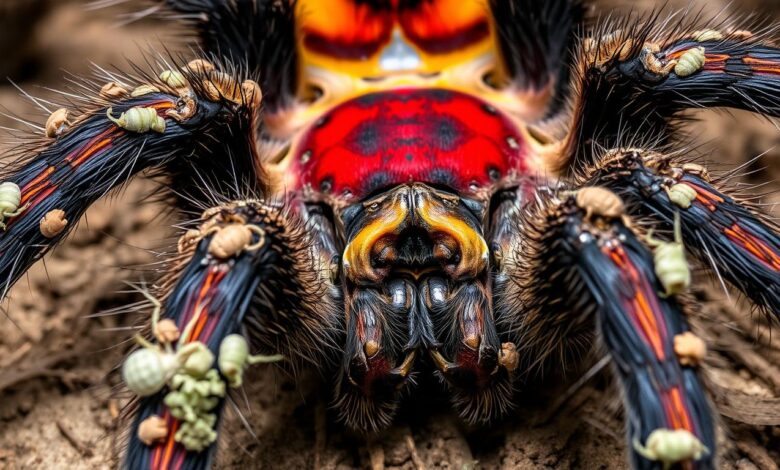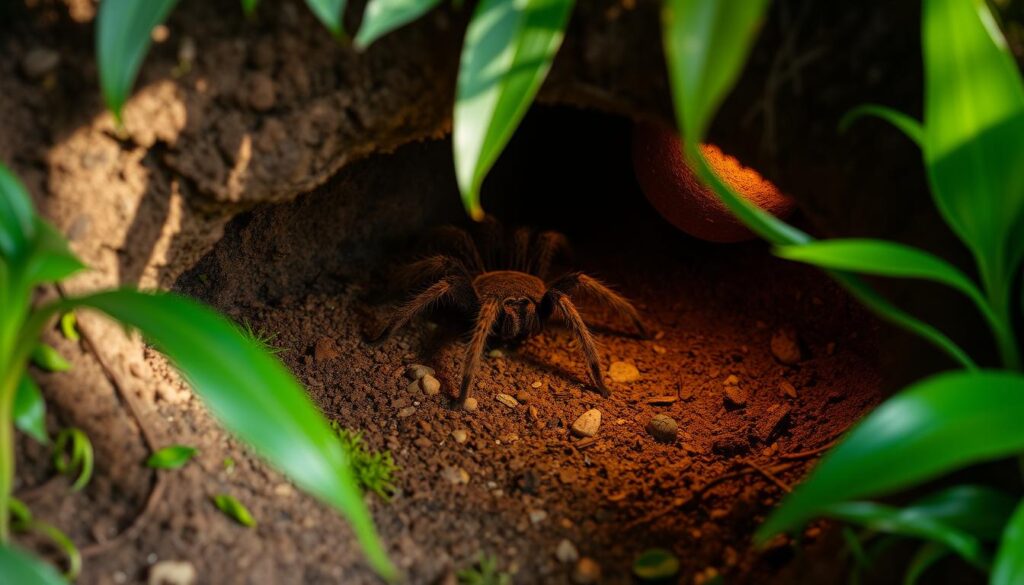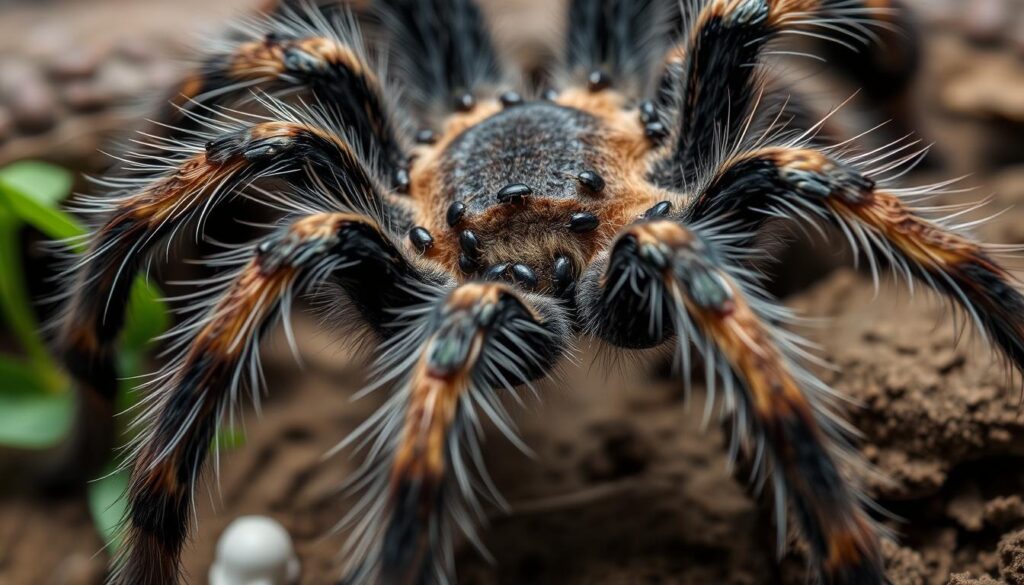Common Diseases in Tarantulas and Their Treatments

Tarantulas are fascinating pets that can sometimes get sick. This guide will cover the most common health issues they face. We’ll talk about parasitic infestations, mite outbreaks, and other diseases. By learning about these, you can keep your tarantula healthy and happy.
Understanding the signs of illness is key. Proper tarantula husbandry is crucial for their health. We’ll look at effective treatments and ways to control pests. This will help keep your tarantula in top shape.
Understanding Tarantula Health
Keeping your tarantula healthy means being alert and knowing what they need. Learn to spot signs of illness like being very tired, not eating, and acting strangely. This way, you can catch tarantula health issues early and help your pet arachnid stay healthy.
Identifying Signs of Illness
Tarantulas can get sick just like any other creature. Paying attention to how they act and look is key to catching signs of illness early. Look out for these signs of sickness:
- Decreased activity or lethargy
- Loss of appetite or refusal to feed
- Abnormal posture or movement
- Discoloration or changes in the exoskeleton
- Unexpected molting or molt-related issues
Importance of Proper Husbandry
Good tarantula husbandry is vital for their health and happiness. This means keeping the right temperature, humidity, and bedding. A habitat that feels like their natural home helps prevent health problems and lets your tarantula live a long, happy life.
| Habitat Requirement | Optimal Range |
|---|---|
| Temperature | 72-84°F |
| Humidity | 60-80% |
| Substrate Depth | 5-8 inches |
| pH Level | 6.5-7.5 |
Knowing how to care for your tarantula and watching for illness signs helps them live a long, healthy life in captivity.

Parasitic Infections in Tarantulas
Tarantulas, the fascinating arachnids, can get infected by parasites, especially mites. These tiny pests can live on a tarantula, causing irritation and skin problems. It’s important to know how to prevent and treat these infections to keep your tarantulas healthy.
Mites and Their Impact
Mites are small, spider-like pests that can live on tarantulas. They can feed on the tarantula’s fluids, causing skin issues. Or, they can dig into the tarantula’s skin, making it hard for the tarantula to molt and grow.
In severe cases, mites can weaken a tarantula’s immune system. This makes it more likely to get other infections and can be deadly.
Mites can have a big impact on tarantulas. Parasitic infections in tarantulas can slow their growth, make them less active, and even cause death if not treated. It’s important to watch your tarantulas closely and prevent tarantula parasites to keep them healthy.
| Mite Type | Impact on Tarantulas | Treatment Options |
|---|---|---|
| Hirstiella Mites | Feed on bodily fluids, causing skin irritation and weakening the tarantula. | Use of miticides or anti-parasitic medications prescribed by a veterinarian. |
| Pterygosoma Mites | Burrow into the exoskeleton, disrupting the molting process and potentially leading to death. | Thorough cleaning of the enclosure, use of miticides, and quarantine of affected individuals. |
| Eutrombidium Mites | Feed on the tarantula’s hemolymph (blood-like fluid), causing anemia and weakening the immune system. | Consult a veterinarian for appropriate treatment options, including the use of anti-parasitic medications. |
By being careful and taking steps to manage mites on tarantulas, you can reduce their harm. This helps keep your tarantulas healthy and happy.

parasites in tarantulas
Tarantulas, the fascinating arachnids we love, can get infected by parasites. These include mites, nematodes, and protozoa. These parasites can really affect their health and happiness.
How common parasites are in tarantulas depends on the type. Some species get infected more than others. Recent studies show that parasites can be found in many tarantulas, highlighting the need for careful watching and quick action.
 Basic Tarantula Care
Basic Tarantula Care
Common parasitic infections in tarantulas are:
- Mites, which burrow into the tarantula’s skin, causing skin problems and irritation.
- Nematodes, or roundworms, that mess with the tarantula’s digestive system. This can make them eat less and lose weight.
- Protozoa, single-celled organisms that can make tarantulas feel tired or even kill them, depending on the type.
How well parasites can be treated in tarantulas varies. Some are harder to get rid of than others. Also, parasites can increase the risk of tarantulas dying if not treated.
It’s up to tarantula owners to watch their pets for signs of parasites. Working with vets is key to getting the right treatment fast. By knowing about common parasites and how to prevent them, we can keep tarantulas healthy and happy.
Tarantula Mite Infestations
Mite infestations can be a big problem for tarantulas. They can cause health issues and even death. Tarantula mite infestations happen often. It’s important to know how to prevent and control them to keep your pets safe.
Prevention and Control Measures
To stop and manage mite infestations in tarantulas, follow these steps:
- Keep your tarantula’s home clean and well-ventilated. Make sure it has the right temperature and humidity. Clean and change the substrate regularly to lower the risk of mites.
- If you think there’s a mite problem, talk to a vet or a tarantula expert. They can suggest safe acaricides to get rid of the mites.
- Quarantine new tarantulas before adding them to your group. This helps prevent them from bringing mites or parasites to your other tarantulas.
- Check your tarantulas often for signs of mites, like white or red mites, being very tired, or acting strangely. Catching mites early helps stop them from spreading.
By taking these steps, you can keep your tarantulas safe from mites. This helps them stay healthy and happy.
Dealing with tarantula mite infestations means being proactive. Always be on the lookout and take steps to keep your tarantulas safe and healthy.
Bacterial Diseases in Tarantulas
Tarantulas can get sick from bacterial diseases, just like any other living thing. These infections can be very serious and even life-threatening if not treated. It’s important to know about the common bacterial diseases and how to treat them to keep your tarantula healthy.
Septicemia is a common bacterial disease in tarantulas. It means harmful bacteria are in the blood. Symptoms include feeling very tired, not wanting to eat, and even organ failure. Another issue is abscesses, which are pockets of pus that can form on the tarantula’s body.
Bacterial infections can also cause breathing problems in tarantulas. For example, bacterial pneumonia makes it hard for them to breathe. This can be very dangerous and can lead to serious health issues if not treated right away.
To deal with bacterial diseases in tarantulas, you should work with a vet who knows about exotic pets. They can do tests, give antibiotics, and tell you how to keep your tarantula from getting sick again.
Knowing about the bacterial diseases that can affect tarantulas and getting help from a vet is key to keeping your tarantula healthy. Keeping their home clean and giving them a good diet also helps prevent and manage these diseases.
Fungal Infections and Their Treatments
Fungal infections are a big worry for tarantula owners. These spiders can get sick from fungi like Aspergillus and Beauveria. If not treated, these infections can be very serious. It’s important to know the signs and how to treat them to keep your tarantula healthy.
Common Fungal Pathogens
Aspergillosis, caused by Aspergillus fungi, is a common infection in tarantulas. It can harm their lungs and might even be deadly. Another fungus, Beauveria bassiana, can infect tarantulas too. This fungus can cause a deadly infection called white fungus.
| Fungal Pathogen | Infection | Symptoms | Treatment |
|---|---|---|---|
| Aspergillus | Aspergillosis | Respiratory distress, lethargy, loss of appetite | Antifungal medications, such as itraconazole or voriconazole |
| Beauveria bassiana | White fungus | White, cotton-like growth on the body, lethargy, loss of appetite | Topical antifungal treatments, such as triazole or benzimidazole compounds |
Quickly finding and treating fungal infections in tarantulas is key. By watching your pet closely and getting vet help early, you can keep your tarantula healthy and happy.
 Tarantula Breeding
Tarantula Breeding
Viral Diseases Affecting Tarantulas
Tarantulas are often seen as healthy creatures, but they can get viral infections. These infections can really affect their health and how long they live. Viral diseases in tarantulas can cause growth problems or affect their nervous system. It’s important to know how to deal with these diseases to keep these spiders healthy.
The Tarantula Paralysis Virus (TPV) is a big concern for tarantula owners. It can make the spider have muscle spasms, feel very tired, and even become paralyzed. TPV can start suddenly, leaving owners worried about their pets. Sadly, there’s no cure for this virus, and the spider’s future looks bad.
Another issue is the Tarantula Malformed Leg Syndrome (TMLS). This virus can make the spider’s legs look deformed or not grow right. This can make it hard for the spider to move and can lower its quality of life. We don’t fully understand TMLS yet, but scientists are working on it.
It’s hard to tell if a tarantula has a viral disease because the signs can be like other health problems. If you think your tarantula is sick, you should see a vet who knows about exotic pets. They can tell you the best way to treat the virus and help your spider.
Keeping your tarantula healthy is key to avoiding viral diseases. Make sure their home is right, feed them well, and keep them stress-free. This helps their immune system stay strong and lowers the chance of getting sick. Working with vets who know about tarantulas can help keep these amazing animals healthy.
| Viral Disease | Symptoms | Prognosis |
|---|---|---|
| Tarantula Paralysis Virus (TPV) | Muscle spasms, lethargy, paralysis | Grave |
| Tarantula Malformed Leg Syndrome (TMLS) | Deformed or stunted legs, mobility issues | Poor |
Tarantula Veterinary Care
Looking after your tarantula’s health is key. It’s important to get professional help when needed. Tarantulas can have health problems that need a vet who knows about arachnids.
Finding a Qualified Veterinarian
Finding a vet who knows about tarantulas can be hard. But it’s vital for your pet’s health. Here are some ways to find a good tarantula vet:
- Look online for vets who specialize in exotic or arachnid medicine.
- Ask other tarantula owners for vet recommendations they trust.
- Check with your local university’s vet school or zoological society for tarantula vet suggestions.
- Make sure to ask about their experience, training, and how they treat tarantulas.
By looking for a skilled tarantula veterinary care expert, you ensure your pet gets the best care.
Tarantula Pest Control Strategies
Keeping your tarantula free from pests is key to their health. Pests like mites can harm your tarantula’s home and health. We’ll look at ways to keep pests away, including using insecticides, keeping their home clean, and isolating new tarantulas.
Dealing with pests is a big worry for tarantula owners. Mites are a big problem because they spread fast and can make your tarantula sick. To fight mites, use insecticides made for arachnids. Always follow the instructions and be careful when using these chemicals.
Keeping your tarantula’s home clean is also important. Clean and disinfect their enclosure often to stop pests. Make sure their home has the right humidity and temperature to keep pests away.
When you add new tarantulas, quarantine them first. This lets you watch them for sickness or pests before mixing them with others. This keeps your tarantulas healthy and pest-free.
Tarantulas in Rural Environments can give you tips on handling pests in their home.
| Pest Control Method | Effectiveness | Advantages | Disadvantages |
|---|---|---|---|
| Approved Insecticides | High | Works well against pests, Made for arachnids | Needs careful use, Could harm tarantula if not done right |
| Habitat Maintenance | Moderate to High | Keeps pests away, Helps tarantulas stay healthy | Takes ongoing work, Might upset tarantula’s home |
| Quarantine Procedures | High | Lowers contamination risk, Checks new tarantulas closely | Needs extra space and effort, Keeps tarantulas apart temporarily |
Using a good tarantula pest control plan helps keep your tarantulas healthy and happy. This makes a safe place for these amazing arachnids to live.
Enhancing Tarantula Health Through Husbandry
Keeping your tarantula healthy is key. It means giving them the best living conditions. This includes the right temperature, humidity, substrate, and enrichment. These things help your tarantula stay well and avoid diseases.
 How to Safely Handle a Tarantula
How to Safely Handle a Tarantula
It’s important to keep the temperature right for your tarantula. For species like the Texas Brown Tarantula and Brazilian Black Tarantula, it should be between 70-80°F. This temperature helps with digestion, activity, and overall health.
Humidity is also crucial for your tarantula’s health. The ideal pH range for their habitat is between 6.5-7.5. This mimics their natural environment. By keeping the moisture and air circulation right, you help your tarantula breathe and stay hydrated.



